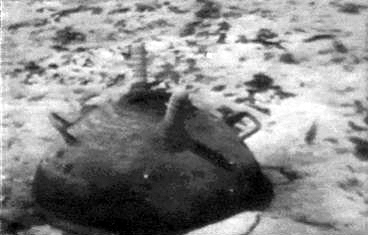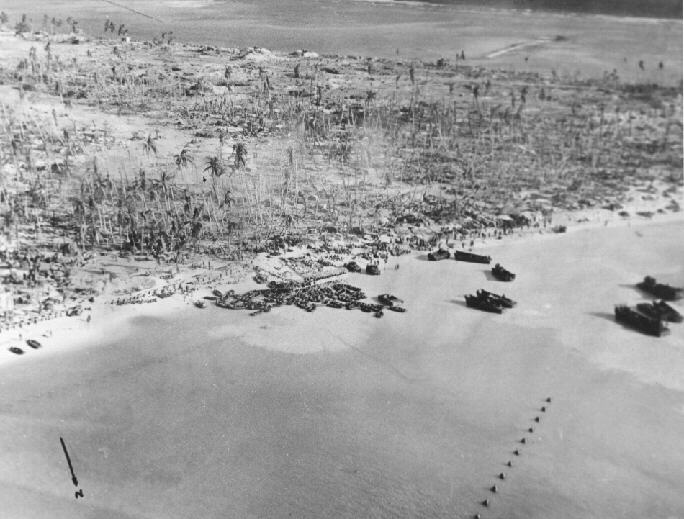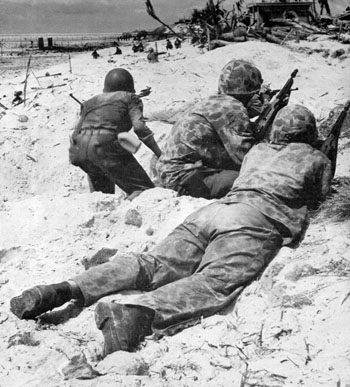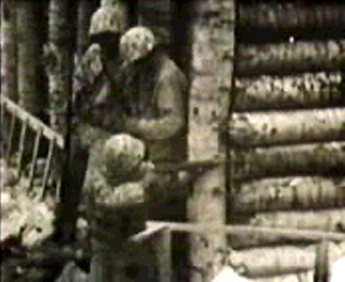Some factual corrections will be made shortly to this account.

Notice the two LVT wrecks, center and center left.
During the planning of the Tarawa invasion mines were of great concern but fortunately the Japanese never finished mining Betio according to their plans. While the Red beaches were left free of mines the Black beaches and Green beach were sown fairly thickly. These mines did little damage in comparison to the entire 76 hours of fighting with two LVTs destroyed. Tradgically eight Marines and corpsmen were killed. One photo of the southwest corner of Betio shows these two destroyed amphibian tractors. The tractor on the left is an LVT1 and the other is an LVT2.1
The first incident occurred about 1700 hrs on 21 November 1943. By this time Green Beach was firmly in control of Maj. Ryan's Marines and 1/6 was coming ashore. One LVT hit a mine and was destroyed killing at least six Marines and Corpsmen. These members of LT 1/6 were 2nd Lt. Marius W. Christenson, Supply Sgt. Page Warren, PhM1C Henry C. Coburn, PhM1C Fred E. Kathan, PhM1C John Kenneth Hildebrand, and PhM2C William W. McGuffin. The only survivor, PhM3C Clinton Lyle Hoatson, was badly wounded.2
Late in the afternoon of D+2 1/6 and 3/6 were located on the south shore of Betio and were low on ammunition. Capt. Thomas B. Royster, the CO of B Co, 2nd Amphibious Tractor Batt., volunteered to resupply these Marines with some of the remaining operational LVTs. Cpl. Lambert Lane volunteered to drive one LVT and some other Marines volunteered to man the guns. This was to be the second incident.
The route Royster to follow is curious because of the danger of mines situation. Alexander concludes that, "...the amtracers by then knew of the mines along Green Beach from the explosion that destroyed one of 1/6s two LVTs the evening of D+1."3 Driving across Betio was the other option but this route could have any number of unforseen pitfalls such as Japanese holdouts or deep craters that might have disabled the few surviving LVTs. In any case Royster decided the water route was the best way to quickly resupply the Marines in need of ammo.
Royster's LVT proceeded south along Green Beach but as they rounded the southwest tip of Betio onto Black Beach they hit one of the large horned anti-boat mines.4 The tremendous explosion destroyed the LVT, killed Royster and Lane, and severely wounded the rest of the crew. Lt. Ward, 2nd Amphibious Tractor Battalion, saw this devastating explosion. He and his men buried Royster in a lone grave at the junction of Black Beach and Green Beach.5 Today both of these wrecks are still visible in the water just off Betio.6

This type of Japanese anti-boat mine destroyed both LVTs.Jim Hildebrand, whose uncle was killed in this accident, is looking for more information about these events. Specifically what type of LVT either of these two groups were used and eyewitness accounts of either of the two events. Email him.
Sources:
1. Jim Hildebrand Tarawa Talk post.
2. According to John Hildebrand's research there may have been other KIAs.
3. Alexander, Utmost Savagery. p.203.
4. Ibid., p. 203.
5. Ibid., p. 204.
6. A 1993 inspection of Betio's Black Beach found no LVT wreckage but two LVT wrecks were located
just off Green Beach, as shown in the picture. One account puts Cpt. Royster's LVT near the intersection
of Green Beach and Black Beach. The problem is that this wreck is an LVT-2, and some evidence shows
that Cpt. Royster was in an LVT-1. The LVT wreck farther north is an LVT-1.




Send an Email:
copyright 2003 T.O.T.W.
Created 11 November 2003 - Updated 6 December 2003

Return to Index